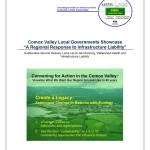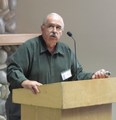Sustainable Service Delivery Links Land Use Planning, Watershed Health and ‘Infrastructure Liability’
Note to Reader:
Green infrastructure and water sustainability — the Comox Valley is demonstrating what can be achieved through a ‘regional team approach’ that is striving for consistency at local government front counters. This is accomplished through sharing of experiences, collaboration, alignment, and pooling of resources to ‘achieve more with less’.
At the 2011 Comox Valley Learning Lunch Seminar Series, the spotlight will be on the unfunded ‘infrastructure liability’ confronting all local governments. This is a driver for a change in the way local governments plan, finance, implement and over time replace infrastructure.
The target audience for the 2011 Series are land use and infrastructure professionals in the local government and development sectors. The image above illustrates the program at a glance.
This article is the fourth in a weekly series that is being released throughout the March – June period. Their purpose is to foreshadow what to expect on these dates:
- April 14 – Regional Collaboration theme
- May 19 – Adaptation theme
- June 23 – Risk Management theme
T his article previews the presentation that Glen Brown will deliver. He is Executive Director with the Ministry of Community, Sport and Cultural Development. His responsibilities encompass local government infrastructure and finance. He will provide context for Sustainable Service Delivery. To download a PDF version, click on Comox Valley Local Governments Showcase A Regional Response to Infrastructure Liability: Sustainable Service Delivery Links Land Use Planning, Watershed Health and Infrastructure Liability.
his article previews the presentation that Glen Brown will deliver. He is Executive Director with the Ministry of Community, Sport and Cultural Development. His responsibilities encompass local government infrastructure and finance. He will provide context for Sustainable Service Delivery. To download a PDF version, click on Comox Valley Local Governments Showcase A Regional Response to Infrastructure Liability: Sustainable Service Delivery Links Land Use Planning, Watershed Health and Infrastructure Liability.
Sustainable Service Delivery: Achieve More With Less
 “The four Comox Valley local governments and the Comox Valley Land Trust are ‘convening for action’ around a water-centric approach to land development. A desired outcome is that water sustainability will be achieved through implementation of green infrastructure practices. We believe this can be accomplished through sharing of experiences and pooling of resources to achieve more with less,” reports Glenn Westendorp, Public Works Superintendent for the Town of Comox. He is Chair of the 2011 Comox Valley Learning Lunch Seminar Series.
“The four Comox Valley local governments and the Comox Valley Land Trust are ‘convening for action’ around a water-centric approach to land development. A desired outcome is that water sustainability will be achieved through implementation of green infrastructure practices. We believe this can be accomplished through sharing of experiences and pooling of resources to achieve more with less,” reports Glenn Westendorp, Public Works Superintendent for the Town of Comox. He is Chair of the 2011 Comox Valley Learning Lunch Seminar Series.
“The theme for Seminar #1 is regional collaboration and alignment. To start the day, we will have two context presentations. In the second, Glen Brown will provide the provincial big picture. He will then explain the significance of the unfunded infrastructure liability and define Sustainable Service Delivery. Finally, he will elaborate on the need for local governments to be nimble, collaborative and integrated.”
 “Infrastructure Liability is a driver for a change in the way local governments plan, finance, implement and over time replace infrastructure. The focus of the 2011 Series is on why and how all those involved in land development have a role to play in achieving Sustainable Service Delivery,” adds Derek Richmond, Manager of Engineering Services with the City of Courtenay.
“Infrastructure Liability is a driver for a change in the way local governments plan, finance, implement and over time replace infrastructure. The focus of the 2011 Series is on why and how all those involved in land development have a role to play in achieving Sustainable Service Delivery,” adds Derek Richmond, Manager of Engineering Services with the City of Courtenay.
To Learn More About the 2011 Series:
Click on Sustainable Service Delivery: Comox Valley Local Governments Release Program Details for 2011 Learning Lunch Series — Water sustainability is more likely to be achieved when land use planning and climate change adaptation are integrated with infrastructure asset management.
Click on A Regional Response to ‘Infrastructure Liability’: Comox Valley Regional Team releases agenda for Seminar #1 in 2011 Learning Lunch Series — All those involved in land development have a role to play in Sustainable Service Delivery.
Infrastructure Management: Challenges & Opportunities
“Local governments in British Columbia are faced with this financial challenge: the initial capital cost of infrastructure is about 20% of the life-cycle cost; the other 80% largely represents a future unfunded liability. Each year, the funding shortfall grows. As infrastructure ages and fails, local governments cannot keep up with renewal and/or replacement. Fiscal constraints provide a powerful  impetus for doing business differently. Green infrastructure is part of a holistic approach to ‘achieve more with less’,” explains Glen Brown.
impetus for doing business differently. Green infrastructure is part of a holistic approach to ‘achieve more with less’,” explains Glen Brown.
“While developers may pay the initial capital cost of municipal infrastructure, local government must assume responsibility for the life-cycle cost associated with operation, maintenance and replacement of infrastructure assets. Often this is not adequately funded through property taxation and utility charges, as various political priorities compete for limited tax dollars. In addition, local governments bear the entire financial burden to stabilize and restore watercourses impacted by increased rainwater runoff volume after land is developed.”
“The term Sustainable Service Delivery describes a life-cycle way of thinking about infrastructure needs and how to pay for those needs over time. The link between asset management and the protection of a community’s natural resources is emerging as an important piece in Sustainable Service Delivery,” emphasizes Glen Brown.
Benefits of Green Infrastructure
“Unfortunately, asset management is sometimes only considered after infrastructure is built. The challenge is to think about what asset management entails BEFORE the asset is built. This paradigm-shift starts with land use planning and determining what services can be provided sustainably, both fiscally and ecologically.”
“The financial burden and environmental impacts associated with ‘pipe-and-convey’ drainage infrastructure contrast with the benefits of ‘green’ infrastructure at a watershed scale: natural landscape-based assets reduce runoff volumes, have lower life-cycle costs, decrease stresses applied to creeks, and enhance urban liveability.”
Doing Business Differently
“The Province’s Living Water Smart and Green Communities initiatives are a catalyst for doing business differently: Start with effective green infrastructure and protect environmental values. Actions and targets in Living Water Smart encourage ‘green choices’ that foster a holistic approach to infrastructure asset management. Two complementary strategies can ‘green’ a community and its infrastructure: preserve and protect natural green infrastructure; and implement designs that soften the footprint of development.”
Level-of-Service Approach
“Level-of-Service is the integrator for everything that local governments do. Appropriate and effective green infrastructure is a way to increase the level-of-service – for example, permeable landscapes that restore the rainfall absorption capacity of the watershed will reduce runoff. This has tangible value because it protects aquatic habitat and hence stream health. This will increase the level of ecological protection. Less runoff will also improve the level of drainage protection during wet weather.”
“To understand the link, think in terms of the ‘Level-of-Service’ an urban tree canopy provides for rainfall interception. As trees grow, the interception capability increases. There is less runoff, less wear-and-tear on creeks, and less need for creek stabilization.”
Integration of Land Use & Asset Management Planning
“Land use planning in British Columbia may be significantly improved when integrated with asset management planning in local governments. The legislative authority for integration of land use planning and asset management, including financial management, already exists within the Local Government Act and Community Charter.”
“Local governments can develop a truly integrated Asset Management Strategy that views the watershed and the strategy through an environmental lens. This outcome can be achieved through a front-end effort that connects with the community and gets the watershed vision right. Then create a blueprint to implement green infrastructure,” concludes Glen Brown.
To Learn More:
To access and download a copy of an article co-authored by Glen Brown and published in the Asset Management BC Newsletter, click on Integrated Rainwater Management: Move to a Levels-of-Service Approach to Sustainable Service Delivery. To learn more about the implications of the infrastructure liability:
 “Asset management usually commences after something is built. The challenge is to think about what asset management entails BEFORE the asset is built,” states Stan Westby, Chair of the Local Government Asset Management Working Group and Chief Administrative Officer with the City of Powell River.
“Asset management usually commences after something is built. The challenge is to think about what asset management entails BEFORE the asset is built,” states Stan Westby, Chair of the Local Government Asset Management Working Group and Chief Administrative Officer with the City of Powell River.
 “Land use planning in British Columbia may be significantly improved when integrated with asset management planning in local governments,” states Kim Fowler, Director of Sustainability for the City of Victoria, and a member of the Local Government Asset Management Working Group.
“Land use planning in British Columbia may be significantly improved when integrated with asset management planning in local governments,” states Kim Fowler, Director of Sustainability for the City of Victoria, and a member of the Local Government Asset Management Working Group.
 “People ‘hear’ the word ‘deficit’ and assume the accountants will fix it all. But people ‘listen’ to the word ‘liability’ and often ask questions or realize some action is necessary,” states Wally Wells, Coordinator for Asset Management BC.
“People ‘hear’ the word ‘deficit’ and assume the accountants will fix it all. But people ‘listen’ to the word ‘liability’ and often ask questions or realize some action is necessary,” states Wally Wells, Coordinator for Asset Management BC.

Posted March 2011




